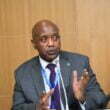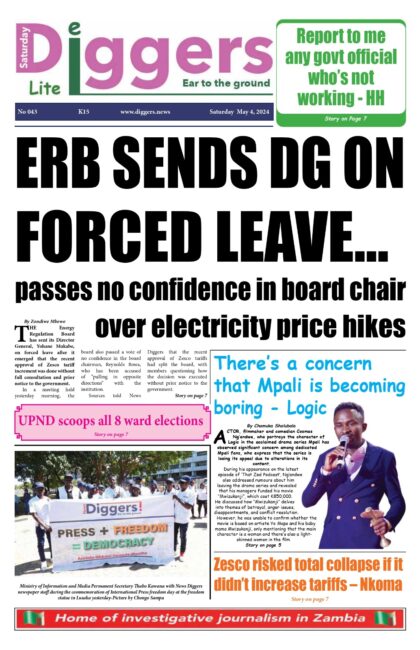Our team has had the entire week to reflect on what the Minister of Finance Margaret Mwanakatwe said at the press briefing on Friday 10th May 2019. Let’s forget her drinking problem for a moment and look at her official performance.
On reflection, we find the Minister had a lot more hot air and waffle in her English accent than substance. The guy in Matero had no idea what she was talking about. There was very little that she said that would put the people of Zambia at ease. There was nothing that she said on policies to deal with the debt crisis. Instead, for instance, we heard that the investment in an airline was a good idea, when most airlines in the world are incurring losses.
Honourable Mwanakatwe has been telling us that debt is like a pregnancy which cannot be hidden, but the truth of the matter is that she has been hiding this debt which has now started protruding in areas where she does not expect. When we went digging for information on Zambia’s debt, we were unable to find anything. On Debt Sustainability Analysis (DSA), the Ministry of Finance website has information on debt for 2012! It’s a totally outdated website of little use. We however did find Zambia’s Debt Sustainability Analysis of 2017 on the IMF website, which candidly reports as follows:
“Debt Sustainability Analysis1 (DSA) indicates that Zambia is at high risk of debt distress, which represents a downgrade from the moderate rating of the previous DSA reported in the 2015 Article IV consultation (IMF Country Report No. 15/152). The present value of the public and publicly guaranteed external debt breaches 40 percent of GDP threshold; it rises from 37 percent in 2016 to 42.6 percent by 2019 and to a peak of 44.3 percent in 2022. The debt-service-to-revenue ratio temporarily breaches its 20 percent threshold in 2022 and 2024 when Eurobond payments fall due. All indicators breach their respective thresholds in the case of extreme shocks.
Overall public sector debt vulnerabilities are also elevated; the fixed primary balance scenario, which keeps the primary deficit-to-GDP ratio unchanged from 2016 (at 2.2 percent), shows the debt ratio rising throughout the forecast period, highlighting the urgent need for fiscal consolidation. Reducing the risk of debt distress requires strong and sustained fiscal consolidation, including measures to increase domestic revenue, strengthen public investment management, and contain fiscal risks (especially contingent liabilities of state-owned enterprises). Adoption and implementation of an appropriate debt management strategy is also critical.”
The biggest problem Zambia is facing is that the minister is frank enough to tell us that government is drawing Central Bank reserves to service its debt. But debt service has a definite periodicity. Most debt service provides for payments falling due every 6 months. For Zambia’s debt, the service payments show clear peaks in January and July, and smaller peaks in March and September. Roughly, based on the pattern of movement in reserves during 2018, unless the government is able to find dollars (by borrowing for Balance of Payment purposes or by selling assets abroad), BoZ reserves could be projected to fall by another $300 million by end-July 2019, bringing them to about $1.14 billion. So, the tank won’t be empty, but it will be drawing close to empty soon and the BoZ’s room for stabilizing markets will be narrowing.
During the 10th May briefing, the minister, out of the blue talked about Zambia’s gold reserves. However, the reported international reserves position excludes gold. Does Zambia have significant gold reserves? And if so, why should we not be told what quantities are there? She further talked about paying the Chinese government in Renminbi, unless the Chinese give the government a discount for paying in Renminbi, that bit doesn’t help much.
Exchange rate, sad news! It’s obvious that Bank of Zambia is actively stabilizing the forex market – which is what they are supposed to do. But given the unsustainable state of affairs, we should be assured that, unless they come up with a pile of dollars from Heaven, the kwacha is going to continue on a significant downward trend.
What we found odd in the minister’s briefing is that she didn’t say anything specific about the copper sector, which is our biggest export. Copper is the biggest source of foreign exchange to this economy. It is a major component of GDP. So, not only is copper missing from the balance of payment section, but the section on GDP doesn’t mention it either. The omission must have been intentional. Is there some added bad news that is being buried here? Could it be that they are aware that the new mining tax regime will lead to a reduction in copper production?
What about the proposed controversial Sales Tax? Is Honourable Mwanakatwe sure that the Zambian business powerhouses have a buy-in on it? What is the position of Zambia Sugar, Dangote, Lafarge, Zambia Breweries and other business giants on this? Are they in support of this Sales Tax? Were they consulted? From our view point, Zambia’s problems are beyond the protruding debt pregnancy, we can smell a huge revolt which will finally grind the country to a halt; unless the minister sobers up and starts seeing the reality of this crisis.













2 Responses
This a government of drunkards that has absolutely no idea how to run or manage the economy of this country. The problem begins at the helm of government. This is a man who has publicly confessed that he doesn’t have what it takes to government. The blame some how squarely lies on the Zambians for making the same mistake twice, I.e. in 2015 and 2016 respectively, by giving this incompetent government the mandate to continue putting us in the mess we find ourselves in today. The challenge through is that Zambians suffer from amnesia, things will get worse if the citizens do not wake up , shine our eyes and remove this government in 2021. We the citizens have the power to fix this mess we are in. Already these failures have always started schemes to hang on to power beyond 2021. They know that they can not win free and fair elections, hence the infamous NDF to manipulate the national constitution to favour their selfish and personal interests at the expense of national interest. We can do the right thing folks, NDF or no NDF, let’s kick this miserable low life government out in 2021…..One Zambia One Nation…..Abashhh corrupted self centered elitist incompetent dictatorship.
Quite shocking analysis . Too good to be false